
A blue fruit decoration on trees looks attractive. Some fruits are edible and even inedible an important food source for birds. We present 17 shrubs and trees with blue berries.
In a nutshell
- Consume only clearly designated edible blue berries
- Berries mostly dark colored
- medium size of many shrubs and trees up to 200 cm
- Fruits and flowers important source of food for insects, birds and wildlife
- Wild shrubs such as the service pear or wild blueberry have moderate yields
Table of contents
- Inedible/poisonous berries
- From B to J
- From K to S
- Edible/edible berries
- From A to F
- From M to W
- frequently asked Questions
Inedible/poisonous berries
You should definitely keep your hands off the blue berries of these trees and shrubs. In the worst case, there is a risk of life-threatening symptoms of poisoning if large quantities are consumed.
A notice: Always remember that even lower doses are often toxic to children and pets.
From B to J
blood currant (Ribes sanguineum)
The blood currant is an ornamental shrub with very beautiful flowers. Originally from California, it is frost-resistant.
- Growth height: 150 - 200 cm
- Flowers: racemose inflorescences, red to pink
- Flowering time: April - May
- Berries: dark purple, with blue frosting, round, up to 10 mm
- Ripening time: from July
- Toxicity: inedible
Three-pointed virgin vine (Parthenocissus tricuspidata)
The virgin vine is often referred to as "wild wine". The reddish autumn color of the leaves is particularly attractive.
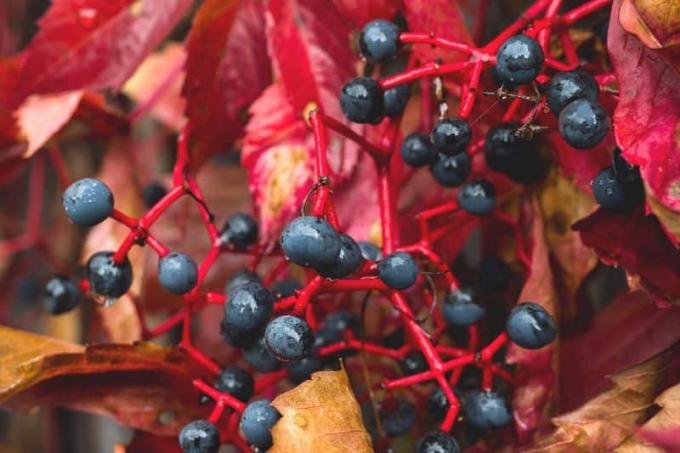
- Growth height: 800 - 1000 cm
- Flowers: yellow-green, in panicles
- Flowering period: July - August
- Berries: blue-black, roundish, up to 8 mm
- Ripening time: from October
- Toxicity: inedible
Tip: Young vines are ideal for greening facades.
Shiny privet (Ligustrum lucidum)
The privet is a popular hedge plant because it is evergreen and very cut compatible is. The fruit decoration, which is inedible for humans, is eaten by birds, which contributes to its spread.
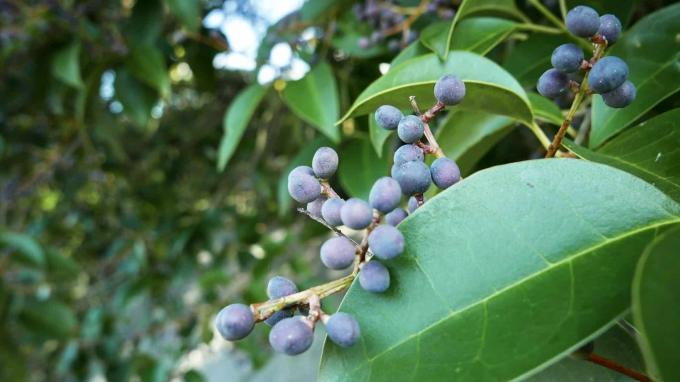
- Growth height: 300 - 600 cm
- Flowers: white, simply paniculate
- Flowering period: late July - September
- Berries: blue-black, roundish, up to 10 mm long
- Ripening time: from September
- Toxicity: inedible
Juliane's barberry (Berberis julianae)
Juliane's barberry copes very well with dry locations. Due to its large thorny leaves, it is often associated with the holly (Ilex) confused.

- Growth height: 200 - 300 cm
- Flowers: yellow, simple, grouped in racemes
- Flowering period: May - June
- Berries: blue-black, frosted, up to 8 mm long
- Ripening time: from October
- Toxicity: slightly toxic
A notice: The native barberry (Berberis vulgaris) has red, elongated fruits. She is edible, but should only be eaten cooked if you have a sensitive stomach.
From K to S
Caucasian ivy (Hedera colchica)
An ivy is an asset to any garden as it is an important source of food for insects late in the year. Compared to the native ivy (Hedera helix), the fruits of the Caucasian ivy tend to be bluish.
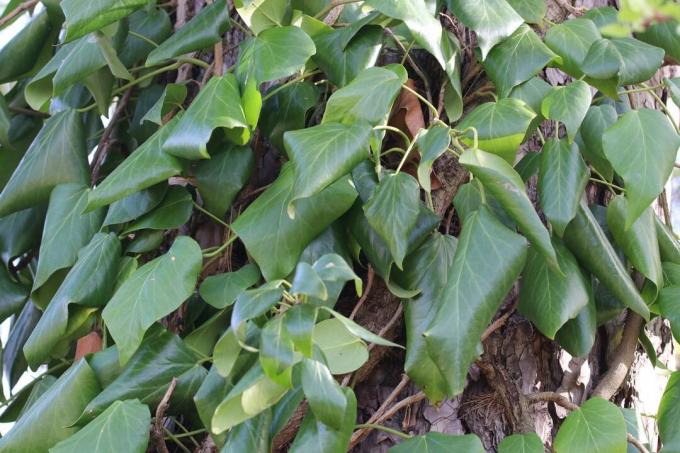
- Growth height: 500 - 700 cm
- Flowers: green-yellow, simple, grouped in umbels
- Flowering period: September - October
- berries: blue-black, 5 - 9 mm, roundish
- Ripening time: October – March
- Toxicity: toxic
Pillow Barberry (Berberis candidula)
With its evergreen foliage that is white underneath, snowy barberry is an attractive shrub all year round. It belongs to the group of blue-berry shrubs and trees whose bright flowers provide an important food source for insects in spring.

- Growth height: 80 - 100 cm
- Flower: bell-shaped, golden yellow
- Flowering period: May - June
- Berries: blue-black, frosted, 2 - 3 mm long
- Ripening time: from the end of September
- Toxicity: slightly toxic
bog bilberry (Vaccinium uliginosum)
Caution is advised here, as it can easily be confused with the wild blueberry. You can recognize the bilberry by its rather oval shape, the brown twigs and the blue-green foliage with entire margins.

- Growth height: 60 - 80 cm
- Flowers: whitish to pink, bell-shaped, racemose
- Flowering period: May - June
- Berries: blue, frosted, 6 - 8 mm long, oblong
- Ripening time: from August
- Toxicity: Toxic in large quantities
A notice: The toxicity of the bog bilberry has not been conclusively clarified. We therefore advise against consumption.
Sadebaum (Juniperus sabina)
The Sade tree is very tolerant of pruning, which is why it is often used as an ornamental plant in Japanese-style gardens. Although the Sade tree is undemanding, it rarely produces fruit.
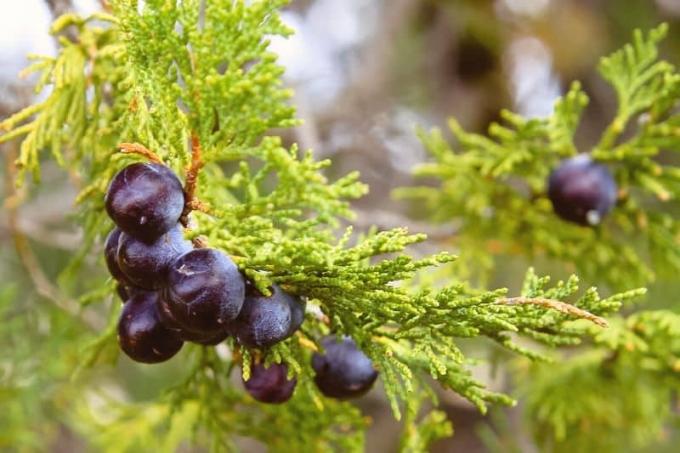
- Growth height: 50 - 60 cm
- Flower: inconspicuous, yellowish, bell-shaped
- Flowering period: May - early June
- Berries: blue-grey, ovate or spherical, pruinose, 5 - 7 mm
- Ripening time: from August
- Toxicity: very toxic
A notice: The Sade tree is often confused with the native juniper (Juniperus communis). However, this one has prickly leaves and stings unpleasantly.
Edible/edible berries
Discover the following blue berries on shrubs and trees, you can access them without hesitation.
From A to F
American blueberry (Vaccinium corymbosum)
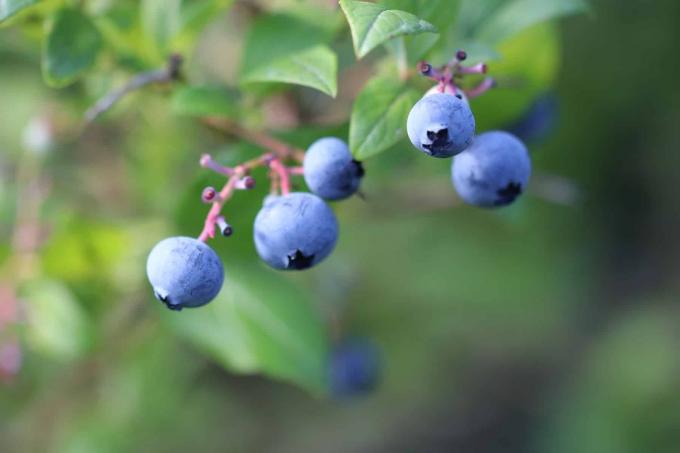
The American blueberry is related to the native blueberry, but its flesh is light-colored. In the garden, however, the American blueberry is preferred as it is easy to cultivate and produces larger fruits.
- Growth height: 100 - 150 cm
- Flower: simple, light pink
- Flowering period: May - June
- Berries: dark blue, frosted, round, 6 - 8 mm
- maturing time: from the end of July
- Toxicity: edible
Blue honeysuckle (Lonicera caerulea)
The blue honeysuckle is an undemanding plant and very easy to care for. It is therefore often used for greening problematic soils that are lean or stony.
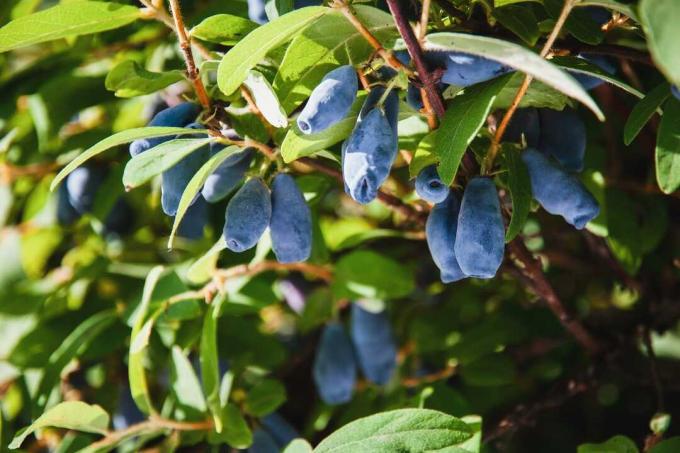
- Growth height: 100 - 200 cm
- Flowers: yellowish to white, simple, cup-shaped
- Flowering time: early April - May
- Berries: black-blue, roundish to elliptical, frosted, fleshy
- Ripening time: May – June
- Toxicity: edible
blackberry (Rubus sect. rubus)
The blue-black, sourly sweet fruits of the blackberry are actually not berries in the botanical sense, but so-called aggregate drupes. Nevertheless, the wild wood is probably one of the best-known shrubs and trees with blue berries.

- Growth height: up to 200 cm
- Flowers: white, rarely pink
- Flowering period: late May - early August
- Berries: blue-black, composed of numerous connected drupes, up to 30 mm
- maturing time: July – October
- Toxicity: edible
Tip: Bramble bushes can quickly spread in the garden. We therefore recommend planting with a rhizome barrier.
Real pear pear (Amelanchier ovalis)
The yield of the pear is rather small, but the fruits are all the more aromatic. When fully ripe, the pear is sweet and tastes somewhat reminiscent of plums.
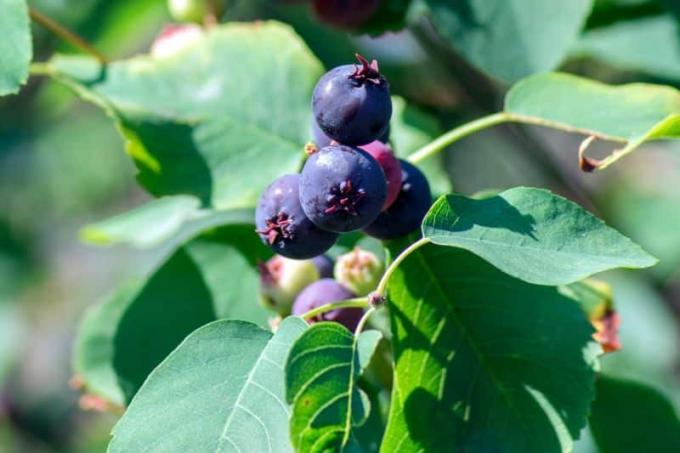
- Growth height: 180 - 350 cm
- Flower: simple, white
- Flowering time: April - May
- Berries: dark red to black-blue, frosted, roundish, up to 10 mm
- Ripening time: July – August
- Toxicity: edible
From M to W
mahonia (Mahonia aquifolium)
Mahonia is a popular ornamental shrub, but its tart berries are also edible. They contain an alkaloid that is broken down by cooking, which is why the fruit should only be eaten after heating.
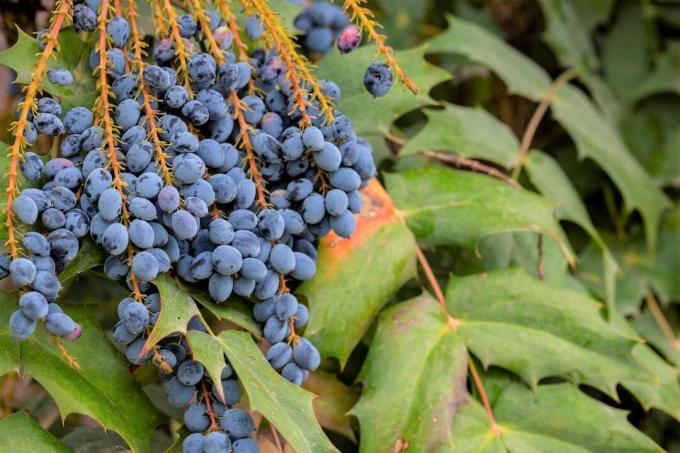
- Growth height: 80 - 120 cm
- Flowers: golden yellow, simple, grape-shaped
- Flowering time: April - May
- Berries: purple-black, bluish pruinescence, as large as an heir, roundish
- Ripening time: from August
- Toxicity: cooked edible
mayberry (Lonicera kamtschatica)
The mayberry originally comes from Siberia and is slowly establishing itself here as an edible berry fruit. It is very robust and tolerates temperatures down to -45°C.

- Growth height: 100 - 150 cm
- Flowers: green-yellow, simple, funnel-shaped
- Flowering time: March
- Berries: light blue to black-blue, frosted, oblong, 8 - 31 mm, oblong, cylindrical
- Ripening time: May – June
- Toxicity: cooked edible
blackthorn (Prunus spinosa)
Blackthorn is often classified as inedible, although the fruits are edible. However, they only become aromatic once they have had a frost, otherwise the mouthfeel is particularly unpleasant and is described as furry.

- Growth height: 150 - 400 cm
- Flower: white, single
- Flowering time: April - May
- Berries: blue-black, round, 6 - 18 mm, frosted
- Ripening time: October – November
- Toxicity: edible
Tip: The blackthorn can often be found as a wild plant along the edges of forests. It can easily be propagated from cuttings in autumn.
juniper (Juniperus communis)
Juniper berries take three years to fully ripen. Over time they change color from green to blue to dark blue to almost black.

- Growth height: 50 - 250 cm
- Flowers: male yellow flowers, female flowers inconspicuous
- Flowering time: April - May
- Berries: blue-black, pruinose, 4 - 5 mm roundish
- Ripening time: in the third year, around late summer
- Toxicity: edible
A notice: In many regions, the juniper is under nature protection due to the long ripening period of the fruit. Cultivated forms that are also edible are often commercially available.
Forest Blueberry (Vaccinium myrtillus)
Where the blueberry can be found, the forest used to be grazed because it needs open vegetation. Due to the fact that forest pastures are becoming increasingly rare, the natural population is decreasing.
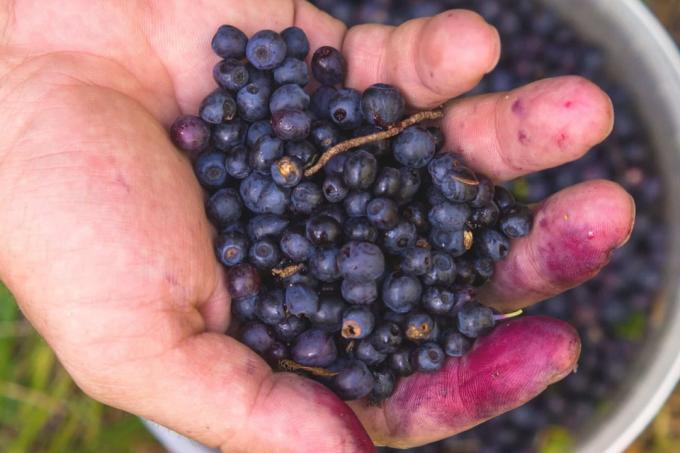
- Growth height: 40 - 60 cm
- Flower: green-red, single
- Flowering period: May - June
- Berries: light to dark blue, roundish, 4 - 8 mm
- Ripening time: July - September
- Toxicity: edible
frequently asked Questions
Yes, most shrubs and trees are suitable for pot cultivation. However, the yield of edible shrubs is often significantly lower. When cultivating in a pot, you must ensure a good supply of water and nutrients. In winter, the root ball must be protected even with frost-resistant plants.
It is advisable to always wash wild-collected berries before consumption. This not only removes impurities, there is also a risk of picking up small pathogens such as those of the fox tapeworm.
Propagation via seeds is possible for most species, but very expensive. In addition, for some species, crossbreeding with other species cannot be ruled out. It is easier to propagate via sinkers, cuttings or root shoots. The young plants obtained in this way usually produce individual blue berries earlier than propagation via seeds.



